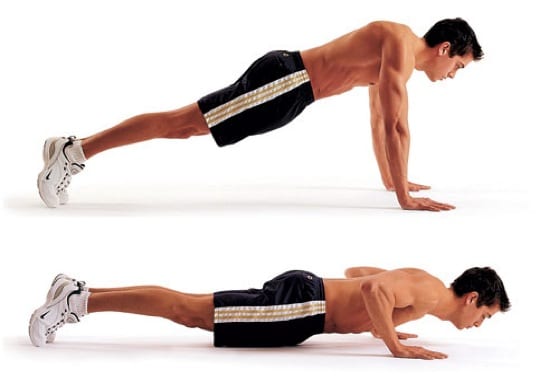By healthiergang writer Gabriele Galasso, Functional Training instructor and K1 competitive athlete.
Press Up
The press up (also known as push up) is a parent exercise in the bodyweight category.
In the language of your country it is often and erroneously known as "flexion", while it is more correct to call it "bending" as we speak of bending of the arm when the two segments around the elbow joint are brought closer while maintaining support on the extremity (in our case the hand), while flexion is defined as the same movement performed without the support of the hand.
The press up is an excellent exercise to train especially the upper body (mainly pectorals, triceps and many shoulder muscles), including the core, which boasts an infinite number of variations.
How is it done?
The basic version of this exercise, from which the variants are then developed, can be performed as follows.
1. Starting position: keeping the core active as for the execution of the plank, position yourself with the body in a prone position (belly down), resting on the hands (kept shoulder-width apart and with the arms perpendicular to the ground, looking for to distribute the weight also on the toes and not only on the metacarpus) and on the tips of the feet (spaced about the width of the hips or kept together).
2. Descent: inhaling, perform the eccentric phase of the exercise, ie without arching the back, bend both arms keeping the humeri at about 45 ° with respect to the torso. The descent phase is completed when the chest reaches the floor.
3. Ascent: exhaling decisively, perform the concentric phase of the exercise, extending the arms and returning to the starting position without losing the activation of the core.

Common mistakes in the execution of the press up
During the execution of a press up, it is essential to check some aspects well:
- Core activation: often neglected, it is a fundamental aspect to avoid injuries. The core must be active in order to keep the back straight and not arched throughout the execution.
- Breathing: it is important to inhale in the eccentric phase (descent) and exhale in the concentric phase (ascent) and not to breathe in an inverse or casual way.
- Attitude of the hands: to avoid boredom in the wrist joints it is important that the weight is well distributed over the whole hand and not only on the metacarpus.
- Cervical: try not to stiffen the cervical area but rather to keep it neutral and relaxed, in line with the entire spine.
- Position of the arms: it is important that the arms are close to the torso or inclined at about 45 ° with respect to it. Performing a push up with the arms wide leads to an overload of the shoulder girdle with a higher incidence of inflammatory problems.
To facilitate correct execution, you can use a few tricks:
- In the relaxing phase, imagine pushing yourself away from a burning surface as a trick against fatigue and mental failure.
- Squeeze the floor tightly with your fingers as if you want to stick them into it when you are doing the last repetitions.

Suggestions
In the case of novice athletes, it is not always possible to perform a press-up correctly: for this there are various types of approach and preparatory; 3 types will be listed below in order of increasing difficulty.
- Push up to the wall: the push up is performed in a standing position, with the feet on the ground and the hands resting on the wall. The dynamics of the movement are the same, assuming that the wall is the floor.
- Push up on the knees: the dynamics of the exercise remain the same, however the support of the lower limbs is on the knees and not on the tips of the feet. Particular attention must be paid to the attitude of the hip which must be well extended and not flexed, i.e. the core must be activated and the femurs must be on the same axis as the torso and not inclined with respect to it.
- Push up with target: the push up is performed in the same way as the standard version, however the descent is constrained by an object that acts as a target (a tennis ball or a pilates ball). In this way the range of motion is limited but there is still an end-of-stroke on which to rely on the execution of the repetition.
The Ladder method for performing the push up
In reality this is a well-coded training methodology used in the field of functional training, but it is still a good method for increasing the number of push ups due to how it was conceived (for training pull ups on the bar). executables.
For a novice athlete who can barely perform 5 push ups, this is a good way to train the exercise while decreasing perceived fatigue.
N push ups (where N represents the number of push ups to fail, and the rest starts at 10 "and increases by 2" each execution)
1 push up? rest 10 "
2 push ups? rest 12 "
3 push ups? rest 14 "
… Push up? rest "previous + 2".
N push up
Once you have reached the series of failing push ups, rest 5 minutes and try to reach the previous number again.
Now that the foundations have been laid, all that remains is to arm yourself with a stopwatch and floor and start practicing!
For more tips on how to do this and other training exercises, follow us here.


























